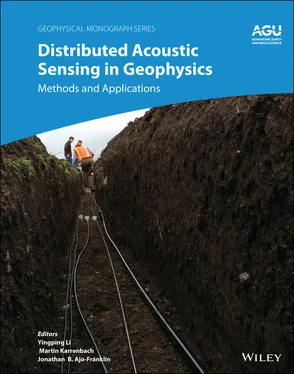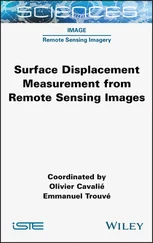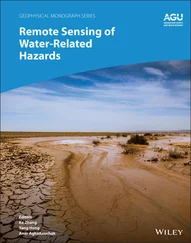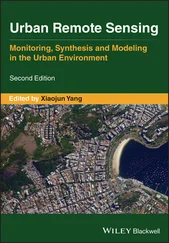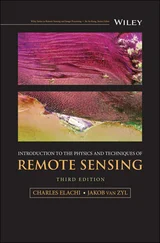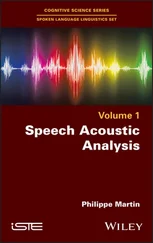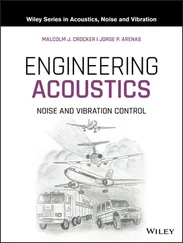2.6. PROCESSING ISSUES
2.6.1. Angle of Incidence
The fiber’s response to P‐waves is somewhat similar to a single‐component geophone. Bakku (2015) compared the far‐field P‐wave response for geophones (cos Θ ) to optical fiber (cos 2 Θ ), where Θ is the angle of incidence of the wave hitting the fiber; 90° indicates normal to the fiber, and 0° is along the axial direction of the fiber. The solid line in Figure 2.9(left) shows the response for a geophone oriented in the axial direction of the fiber, and the dashed line shows the fiber response for P‐waves. They are identical for normal and perpendicular angles but differ at intermediate angles, with the largest difference at 45°. Figure 2.9(right) shows the far‐field S‐wave response (sin2 Θ ) of the fiber by the solid line and the S‐wave response (sin Θ ) of a geophone oriented along the axial direction of the fiber by the dotted line. The response for S‐waves is extremely different because the maximum response for the fiber occurs at 45°, as compared to 90° for the geophone. At 90° the DAS S‐wave response is zero. This is because the S wave is merely translating the cable up and down and does not extend or compress the fiber at the normal (90°) angle to the fiber. Individual data points in Figure 2.9come from a field example of a VSP that matches the theory.
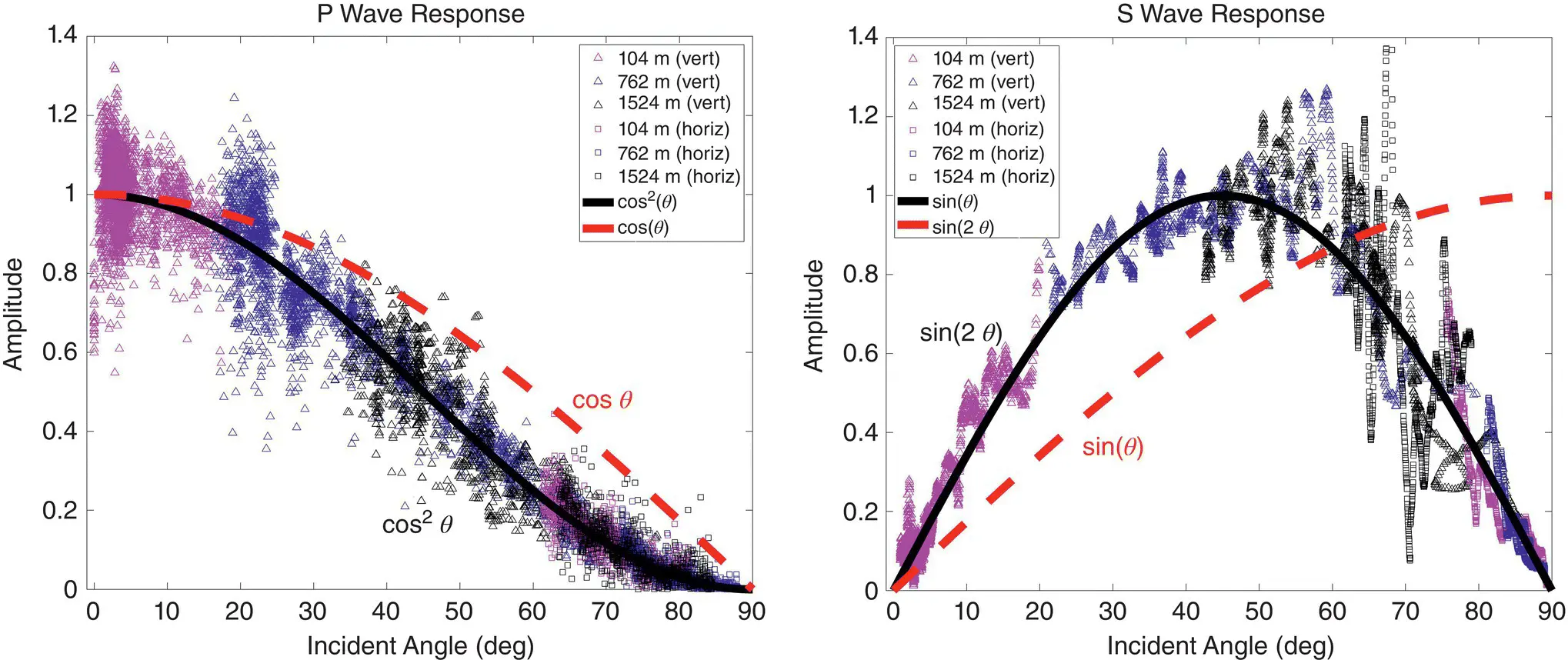
Figure 2.9 Angular response of the fiber to P waves (left) and S waves (right). The lines show the theoretical response for DAS (solid) and geophones (dotted), and the symbols show the extracted amplitude response from a field VSP data set.
Source: Wu et al. (2017).
2.6.2. Single Component vs. Three Components
A challenge with DAS data sets is that there is only a single component detecting strain along the axial length of the fiber. Conventional VSP and earthquake seismic recordings are typically acquired with three components (3C): one vertical and two orthogonal horizontal components. (Exploration surface seismic is normally acquired with only vertical component geophones.) While there are 3C optical sensors available that can be spliced into a fiber‐optic cable, they are point sensors not directly related to DAS measurements. Research is ongoing to create 3C measurements using sets of helically wound fibers in a single cable; currently, they are not commercially available (Ning & Sava, 2018). However, this limitation restricts the ability of DAS data sets to locate the azimuthal direction of seismic waves hitting the fiber; in this way, it is quite similar to single‐component geophone data sets.
2.7. DATA QUALITY: DAS VS. GEOPHONE COMPARISONS
2.7.1. Lower Intrinsic SNR and Higher Channel Density
The intrinsic SNR level of DAS data sets is lower than the corresponding geophone data sets because of, in part, the noise sources previously listed. However, in addition to those noise sources, there is an ambient noise floor present in the DAS recording system. One method to help improve this is to make repeated measurements and stack them together to increase the SNR. Another option is to use the increased number of data channels, which are typically every meter (although some systems record channels at less than a meter and others record every few meters). In contrast with conventional recording using widely spaced sensors, DAS data sets allow the ability to use neighboring channels to help improve the SNR by use of the redundancy of this information (Cheng et al., 2019). Typically, DAS channel spacing is considerably smaller than the seismic wavelengths to be measured; therefore, we do not expect rapid changes for the signal from channel to channel, allowing multi‐trace filters (e.g., median filters, running mean filters, etc.) to help improve the SNR. In addition, wave types (e.g. tube waves and ground roll) typically aliased in widely spaced sensor data can be more easily filtered with tools such as f‐k filtering acquired using DAS.
2.7.2. Strain, Strain Rate, and Particle Velocity
Geoscientists are accustomed to working with geophone and seismometer data where the measurement is displacement, velocity, and acceleration—while strain and strain rate data not as commonly used. Daley et al. (2016) described one method to convert from strain rate to an equivalent geophone response. Here, we generalize the process. Figure 2.10shows the relationship between the various products that can be produced from a DAS data set. The native measurement from an IU is the phase from Equation 2.1. From a simple scalar multiplication, the relative strain from Equation 2.2can be obtained. Converting the relative strain to strain rate requires a simple time derivative to be applied; to convert the strain rate data to velocity requires a spatial integration. One might think that velocity is the final destination for our processing, but, if it is necessary to compare it to geophone data, then the instrument response of the geophone should be included as the last step to simulate geophone data. Further, it is possible to go backward from the simulated geophone response, or actual geophone data, to any of the previous products using the inverse operation.
There have been many published comparisons of DAS and geophone data sets (Mestrayer et al., 2011; Willis et al., 2016; Olofsson & Martinez 2017; Wu et al., 2017). Favorable geophone data comparisons were published using both strain rate and strain rate converted to geophone response. Using relative strain data appears quite attractive because it is much richer in low frequencies. Recall that the time derivative to convert relative strain to strain rate is a linear ramp function in the frequency domain, significantly reducing low frequencies and boosting high frequencies. However, as observed in Figure 2.5, relative strain data are quite sensitive to the temperature drift that often swamps in amplitude the desired seismic signal. From a practical point of view, if the goal of acquiring DAS data is to obtain geophone‐like data, then using strain rate or strain rate converted to geophone response is attractive. However, if the goal is low‐frequency deformation or earthquake measurements, then it is possible that, with careful filtering of the relative strain data, it would be the best option.
This chapter discussed many unique aspects of acquiring DAS data. If possible, it is preferable to acquire data using single‐mode instead of multi‐mode fiber. Better SNR data are obtained with permanently cemented fiber cable, but it is still possible to obtain fit‐for‐purpose data using retrievable fiber deployment methods. Field engineers need to be trained to keep the fiber‐optic connections clean and the cable unbent. To obtain reliable DAS data, the IU should employ a differential phase scheme—nearly all current commercial systems use this method. It is important to ensure the timing information is preserved with DAS data; thus, GPS timing units will require appropriate access to an external antenna.
Gauge length continues to be an important decision. As discussed, a short gauge allows full fidelity of the resulting seismic signal, but a long gauge increases the SNR. As such, it is necessary to review the gauge length for the required data bandwidth. Pulse width can be easily chosen to match the gauge length to obtain the best illumination of the fiber. Fading is a natural feature of DAS acquisition and should always be addressed with both hardware and software. IUs using more than one light frequency are intrinsically better at reducing fading. Post‐acquisition processing can address fading, particularly for land data sets where multiple vibrator sweeps are collected. Common‐mode noise is caused by ambient sounds around the IU; therefore, keeping this area quiet helps prevent it. Further, simple post‐acquisition processing will remove most of it.
Читать дальше
